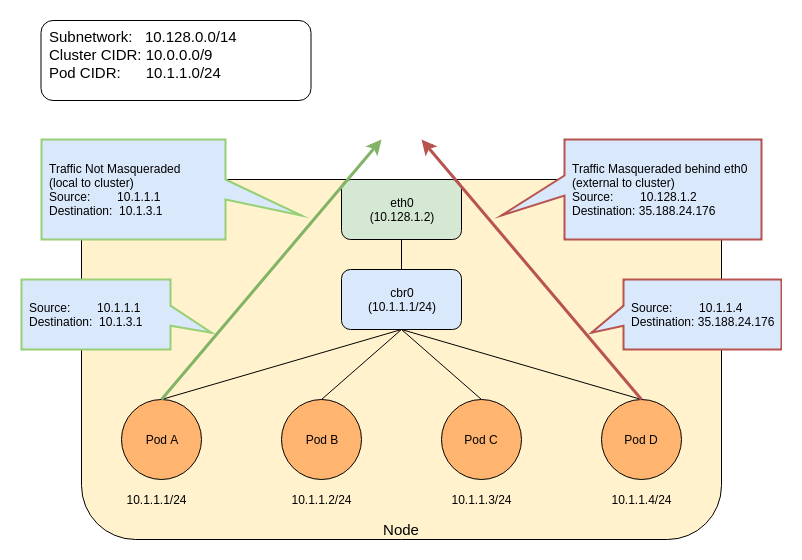Black lives matter.
We stand in solidarity with the Black community.
Racism is unacceptable.
It conflicts with the core values of the Kubernetes project and our community does not tolerate it.
We stand in solidarity with the Black community.
Racism is unacceptable.
It conflicts with the core values of the Kubernetes project and our community does not tolerate it.
This page shows how to configure and enable the ip-masq-agent.
You need to have a Kubernetes cluster, and the kubectl command-line tool must be configured to communicate with your cluster. If you do not already have a cluster, you can create one by using Minikube, or you can use one of these Kubernetes playgrounds:
To check the version, enterkubectl version.
The ip-masq-agent configures iptables rules to hide a pod's IP address behind the cluster node's IP address. This is typically done when sending traffic to destinations outside the cluster's pod CIDR range.
The ip-masq-agent configures iptables rules to handle masquerading node/pod IP addresses when sending traffic to destinations outside the cluster node's IP and the Cluster IP range. This essentially hides pod IP addresses behind the cluster node's IP address. In some environments, traffic to "external" addresses must come from a known machine address. For example, in Google Cloud, any traffic to the internet must come from a VM's IP. When containers are used, as in Google Kubernetes Engine, the Pod IP will be rejected for egress. To avoid this, we must hide the Pod IP behind the VM's own IP address - generally known as "masquerade". By default, the agent is configured to treat the three private IP ranges specified by RFC 1918 as non-masquerade CIDR. These ranges are 10.0.0.0/8, 172.16.0.0/12, and 192.168.0.0/16. The agent will also treat link-local (169.254.0.0/16) as a non-masquerade CIDR by default. The agent is configured to reload its configuration from the location /etc/config/ip-masq-agent every 60 seconds, which is also configurable.

The agent configuration file must be written in YAML or JSON syntax, and may contain three optional keys:
Traffic to 10.0.0.0/8, 172.16.0.0/12 and 192.168.0.0/16) ranges will NOT be masqueraded. Any other traffic (assumed to be internet) will be masqueraded. An example of a local destination from a pod could be its Node's IP address as well as another node's address or one of the IP addresses in Cluster's IP range. Any other traffic will be masqueraded by default. The below entries show the default set of rules that are applied by the ip-masq-agent:
iptables -t nat -L IP-MASQ-AGENT
RETURN all -- anywhere 169.254.0.0/16 /* ip-masq-agent: cluster-local traffic should not be subject to MASQUERADE */ ADDRTYPE match dst-type !LOCAL
RETURN all -- anywhere 10.0.0.0/8 /* ip-masq-agent: cluster-local traffic should not be subject to MASQUERADE */ ADDRTYPE match dst-type !LOCAL
RETURN all -- anywhere 172.16.0.0/12 /* ip-masq-agent: cluster-local traffic should not be subject to MASQUERADE */ ADDRTYPE match dst-type !LOCAL
RETURN all -- anywhere 192.168.0.0/16 /* ip-masq-agent: cluster-local traffic should not be subject to MASQUERADE */ ADDRTYPE match dst-type !LOCAL
MASQUERADE all -- anywhere anywhere /* ip-masq-agent: outbound traffic should be subject to MASQUERADE (this match must come after cluster-local CIDR matches) */ ADDRTYPE match dst-type !LOCAL
By default, in GCE/Google Kubernetes Engine starting with Kubernetes version 1.7.0, if network policy is enabled or you are using a cluster CIDR not in the 10.0.0.0/8 range, the ip-masq-agent will run in your cluster. If you are running in another environment, you can add the ip-masq-agent DaemonSet to your cluster:
To create an ip-masq-agent, run the following kubectl command:
kubectl apply -f https://raw.githubusercontent.com/kubernetes-incubator/ip-masq-agent/master/ip-masq-agent.yaml
You must also apply the appropriate node label to any nodes in your cluster that you want the agent to run on.
kubectl label nodes my-node beta.kubernetes.io/masq-agent-ds-ready=true
More information can be found in the ip-masq-agent documentation here
In most cases, the default set of rules should be sufficient; however, if this is not the case for your cluster, you can create and apply a ConfigMap to customize the IP ranges that are affected. For example, to allow only 10.0.0.0/8 to be considered by the ip-masq-agent, you can create the following ConfigMap in a file called "config".
Note: It is important that the file is called config since, by default, that will be used as the key for lookup by the ip-masq-agent:nonMasqueradeCIDRs: - 10.0.0.0/8 resyncInterval: 60s
Run the following command to add the config map to your cluster:
kubectl create configmap ip-masq-agent --from-file=config --namespace=kube-system
This will update a file located at /etc/config/ip-masq-agent which is periodically checked every resyncInterval and applied to the cluster node. After the resync interval has expired, you should see the iptables rules reflect your changes:
iptables -t nat -L IP-MASQ-AGENT
Chain IP-MASQ-AGENT (1 references)
target prot opt source destination
RETURN all -- anywhere 169.254.0.0/16 /* ip-masq-agent: cluster-local traffic should not be subject to MASQUERADE */ ADDRTYPE match dst-type !LOCAL
RETURN all -- anywhere 10.0.0.0/8 /* ip-masq-agent: cluster-local
MASQUERADE all -- anywhere anywhere /* ip-masq-agent: outbound traffic should be subject to MASQUERADE (this match must come after cluster-local CIDR matches) */ ADDRTYPE match dst-type !LOCAL
By default, the link local range (169.254.0.0/16) is also handled by the ip-masq agent, which sets up the appropriate iptables rules. To have the ip-masq-agent ignore link local, you can set masqLinkLocal to true in the config map.
nonMasqueradeCIDRs:
- 10.0.0.0/8
resyncInterval: 60s
masqLinkLocal: true